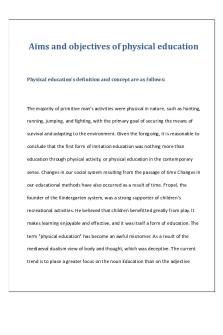Abstract, Aims & Objectives PDF

| Title | Abstract, Aims & Objectives |
|---|---|
| Author | Ethan Paver |
| Course | Research Skills For Biology |
| Institution | Bath Spa University |
| Pages | 3 |
| File Size | 65.5 KB |
| File Type | |
| Total Downloads | 88 |
| Total Views | 160 |
Summary
How to properly write an abstract, aims, and objectives for a professional scientific paper. Can also be applied to dissertation work. Taught by: Dr. Anil De Sequiera...
Description
Aims, Objectives, Abstract, and Introduction What is an abstract? •An abstract is a particular kind of summary •It is short •It is a single paragraph •Uses scientific language •Summarises the major parts of the paper •Materials, methods, results, discussion •Never includes citations •Never includes citations
When are Abstracts used? Part of a research article – Most common Chapter in a book Library reference tools Presentations at scientific meetings Posters at scientific meetings Often the only part read - must be good!
How are Abstracts written? Introductory statement Research methodology Results or other main points Concluding statement explaining the results
Aims and Objectives Choosing the questions Why are you carrying out this study? Why is this study important? When, where and how are you going to carry out the study? What limitations are there? Has anyone else done a similar study? Why is yours different? Finally: How could you summarise your whole study into a single question?
Make your question specific
Does drinking a caffeinated drink improve reaction times? Do wood mice prefer to live in barley or wheat fields? Does eating liquorice reduce rates of bowel cancer? The more specific the question the easier it is to plan the rest of your study in terms of methodology and data analysis
What do Aims and Objectives do? The aim of a research project is a statement of what the research will do. The aim is a strategic statement of what the researcher would like to do if no constraints exist. The aim provides an indication of the context of the research project.
Where do they fit? At the end of the introduction, there should be a section giving the aims and objectives, and in some cases the testable hypothesis of the proposed work, written mainly in the present tense, with hypothetical outcomes in the future tense
Know your aims and objectives Be clear about the aims and objectives early on Aims - general statements concerning the overall goals Objectives - specific stages that must be completed to achieve your aims and goals (in order) Objectives are statements within aims, tactical statements that, in the light of constraints, translate the aims into inter-related yet self-sufficient coherent statements. Objectives specify what will be known at the end of the project that isn’t known at its beginning and has been revealed by the research.
Hypotheses Not all research projects have hypotheses Fundamental research; Where there is little previous research However, for the vast majority of research it is possible and important to draw on theory and literature to formulate hypotheses. Where hypotheses are formulated they act as: A focus for the work; Describe the relationships to be tested; Define the boundary of the project. An hypothesis is a statement of conjecture which can be tested rigorously to remove
as much of the supposition (uncertainty) and replace it with knowledge (probability) as possible. In testing an hypothesis you should seek to provide evidence, through the results of testing, to support or refute the statement at an appropriate level of probability (confidence). The specification of confidence normally involves the use of statistics.
Introductions Can be divided into 3 sections 1 - the general topic of the article in the light of the current literature. Explanation should be made in clear, precise terms as if the reader is somewhat unfamiliar with the subject (but not of science). 2 - the specific subject matter. Highlight the problem, fundamental references related to the topic should be discussed. At this point, the problems should be reduced to one issue as far as possible 3 - Aims and objectives, should include the solution in which we will describe the information we generated, and related data...
Similar Free PDFs

Abstract, Aims & Objectives
- 3 Pages

Money market aims and objectives
- 12 Pages

Abstract
- 11 Pages

Abstract
- 2 Pages

1 Aims and values
- 4 Pages

Abstract 1
- 1 Pages

Screenen en evalueren - AIMS
- 1 Pages

Abstract - dfdxf
- 1 Pages

Abstract Krypton
- 1 Pages

FARC abstract - Rafa Daza
- 2 Pages

Abstract 1 - Imagología
- 5 Pages

IM Abstract Algebra Manamtam
- 63 Pages
Popular Institutions
- Tinajero National High School - Annex
- Politeknik Caltex Riau
- Yokohama City University
- SGT University
- University of Al-Qadisiyah
- Divine Word College of Vigan
- Techniek College Rotterdam
- Universidade de Santiago
- Universiti Teknologi MARA Cawangan Johor Kampus Pasir Gudang
- Poltekkes Kemenkes Yogyakarta
- Baguio City National High School
- Colegio san marcos
- preparatoria uno
- Centro de Bachillerato Tecnológico Industrial y de Servicios No. 107
- Dalian Maritime University
- Quang Trung Secondary School
- Colegio Tecnológico en Informática
- Corporación Regional de Educación Superior
- Grupo CEDVA
- Dar Al Uloom University
- Centro de Estudios Preuniversitarios de la Universidad Nacional de Ingeniería
- 上智大学
- Aakash International School, Nuna Majara
- San Felipe Neri Catholic School
- Kang Chiao International School - New Taipei City
- Misamis Occidental National High School
- Institución Educativa Escuela Normal Juan Ladrilleros
- Kolehiyo ng Pantukan
- Batanes State College
- Instituto Continental
- Sekolah Menengah Kejuruan Kesehatan Kaltara (Tarakan)
- Colegio de La Inmaculada Concepcion - Cebu



